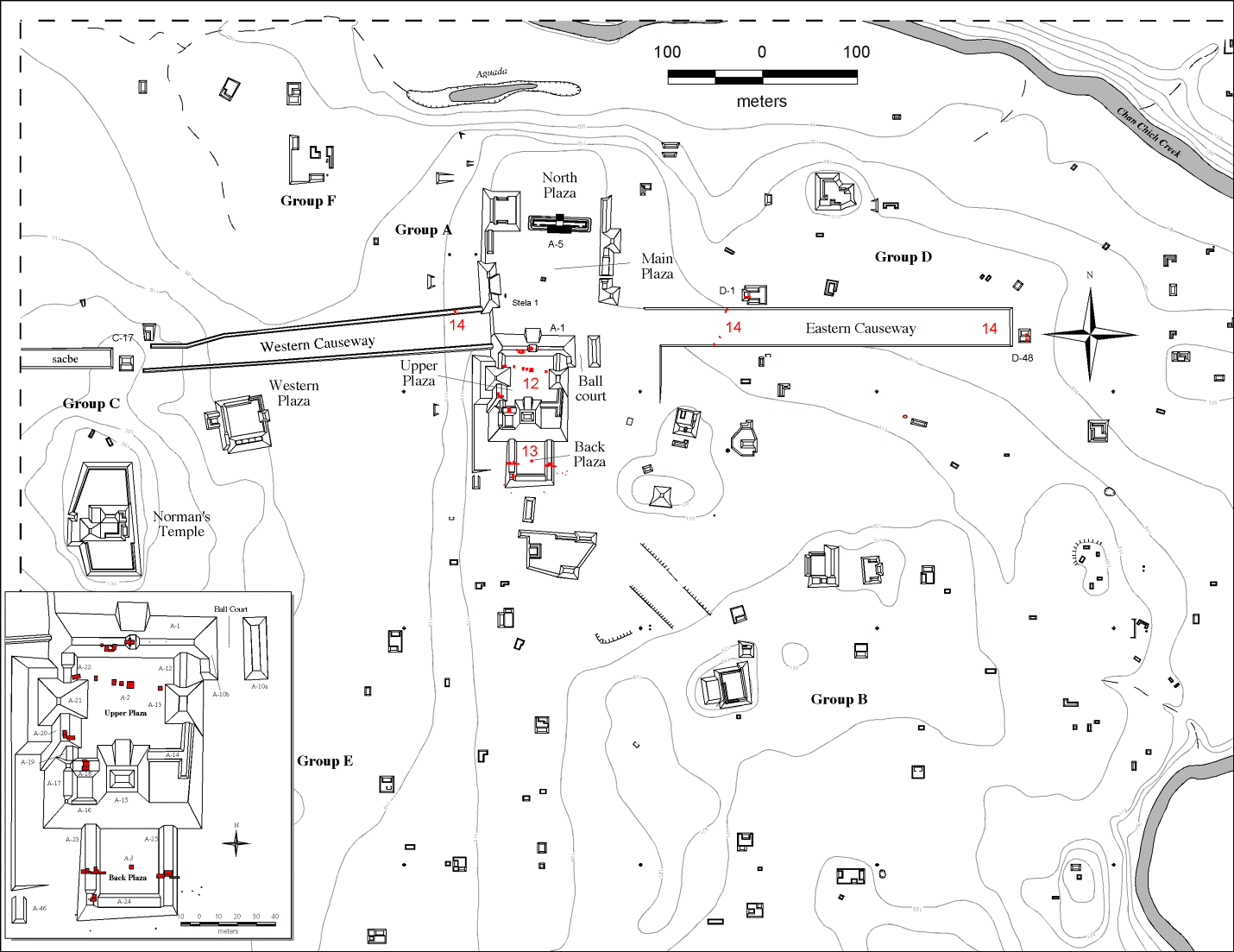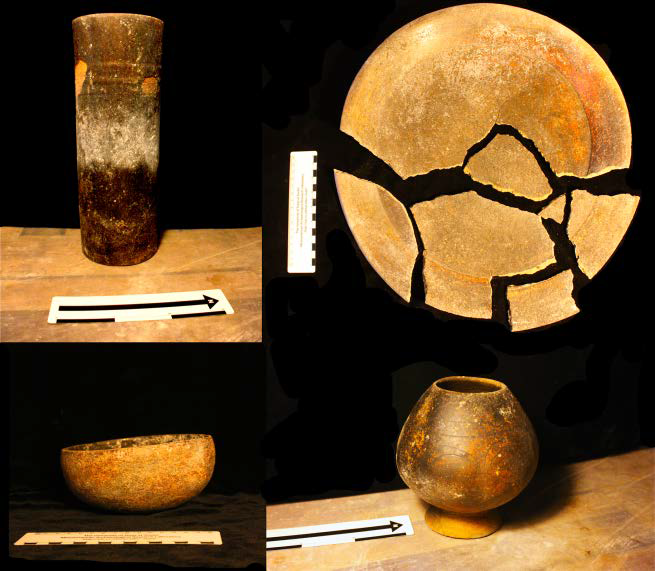Chan Chich Site on:
[Wikipedia]
[Google]
[Amazon]
The Chan Chich Site, an

 While the other structures were examined before in previous excavations, courtyard A-3 remains untouched until the 2014 excavation. This large courtyard, located south of the Upper Plaza, contains Structures A-23, A-24, and A-25. Examination of the site concludes that the courtyard was occupied in the Late Classic Period through the Terminal Classic period. Artifacts extracted from this location are shown on the right, identified as Vessel 1, Vessel 3, Vessel 2, and Vessel 4 starting clockwise from the upper left corner. Structure A-23 contains additional knives that archaeologists believe to been constructed by using deer bone, ground stones, and broken bifaces as materials. The analysis of structure A-25 and the artifacts found there is unfinished, and information about the location will remain unclear until future excavation of the site is to be held.
While the other structures were examined before in previous excavations, courtyard A-3 remains untouched until the 2014 excavation. This large courtyard, located south of the Upper Plaza, contains Structures A-23, A-24, and A-25. Examination of the site concludes that the courtyard was occupied in the Late Classic Period through the Terminal Classic period. Artifacts extracted from this location are shown on the right, identified as Vessel 1, Vessel 3, Vessel 2, and Vessel 4 starting clockwise from the upper left corner. Structure A-23 contains additional knives that archaeologists believe to been constructed by using deer bone, ground stones, and broken bifaces as materials. The analysis of structure A-25 and the artifacts found there is unfinished, and information about the location will remain unclear until future excavation of the site is to be held.
archaeological site
An archaeological site is a place (or group of physical sites) in which evidence of past activity is preserved (either prehistoric or recorded history, historic or contemporary), and which has been, or may be, investigated using the discipline ...
, is a moderately sized ancient Maya City
Maya cities were the centres of population of the pre-Columbian Maya civilization of Mesoamerica. They served the specialised roles of administration, commerce, manufacturing and religion that characterised ancient cities worldwide.Sharer & Tra ...
located approximately 4.25 km east of the Belizean border with Guatemala
Guatemala, officially the Republic of Guatemala, is a country in Central America. It is bordered to the north and west by Mexico, to the northeast by Belize, to the east by Honduras, and to the southeast by El Salvador. It is hydrologically b ...
and siting along Chan Chich Creek in the Three Rivers adaptive region of Belize
Belize is a country on the north-eastern coast of Central America. It is bordered by Mexico to the north, the Caribbean Sea to the east, and Guatemala to the west and south. It also shares a maritime boundary with Honduras to the southeast. P ...
. The site was occupied from the beginning of the Middle Pre-Classic era (around 800 BC) through the Terminal Classic era (around 850 AD). The Chan Chich Archaeological Project (CCAP) and the Belize Estates Archaeological Survey Team (BEAST) sought to survey and excavate the site in years that dates back to as early as the 1990s which found a Terminal Neoclassic Tomb. The most recent investigation which yielded more findings came in the year 2014, with goals to examine the site and reconstruct an accurate model and map for it.
Excavations and Interpretations

1990s Excavation Overview
In the 1990s, the Chan Chich Dynastic Architecture Project (CCDAP) was established to initiate an excavation party for the site of Chan Chich. Excavations in the Upper Plaza is essential in showcasing the Maya kings and their important relationship with otherarchitecture
Architecture is the art and technique of designing and building, as distinguished from the skills associated with construction. It is both the process and the product of sketching, conceiving, planning, designing, and construction, constructi ...
and artifacts found there. One of the most important findings was the tomb of a Terminal Pre-Classic king found during the late 1990s. Archaeologists
Archaeology or archeology is the study of human activity through the recovery and analysis of material culture. The archaeological record consists of Artifact (archaeology), artifacts, architecture, biofact (archaeology), biofacts or ecofacts, ...
dug in the Upper Plaza and found the tomb buried beneath a small shrine platform. Results concluded that the king was one of the earliest Maya kings of the eastern Maya lowlands. There is an important relationship Mayan monumental architecture and the kings during the Classic period, but there lacks sufficient evidence to conclude the relationship between the earliest of Maya kings and buildings.
2014 Excavation Locations
Structure A-15
Source Filmmaker Software (SfM) uses correlation and set algorithms in conjunction with the 1,799 pictures of Structure A-15 (located in the Upper Plaza) to create a 3D model of Structure A-15. This model is helpful in visualizing data and making it easier for archaeological analysis. While physical artifacts was not found in Structure A-15, the model was able to visualize certain features like the five looters' trenches/tunnels. A full analysis of the area is currently incomplete.Structure A-18
Adjacent to the northwest corner of Structure A-15 is the small point known as Structure A-18. A large room with an off-centered doorway was discovered facing south of the courtyard. Inside includes a skeletal remain of an individual, yet no artifacts were extracted at that time.Structure A-1
Structure A-1 is the largest structure at Chan Chich, consisting of two tandem range buildings both with four rooms on both sides. Located in the middle of the two tandem buildings lies a penultimate phase floor, which was discovered when archaeologists dug beneath the central landing. "Inside the cut was Cache CC-C01, consisting of 17 obsidian blades, and a crudely constructed crypt containing the remains of a single human interment (Burial CC-B11) and four complete Achote Group ceramic vessels, ceramic sherds,lithic flake
In archaeology, a lithic flake is a "portion of rock (geology), rock removed from an objective piece by percussion or pressure,"Andrefsky, W. (2005) ''Lithics: Macroscopic Approaches to Analysis''. 2d Ed. Cambridge, Cambridge University Press and ...
s, three obsidian
Obsidian ( ) is a naturally occurring volcanic glass formed when lava extrusive rock, extruded from a volcano cools rapidly with minimal crystal growth. It is an igneous rock. Produced from felsic lava, obsidian is rich in the lighter element ...
microblades, and a small piece of pink shell."
Courtyard A-3
 While the other structures were examined before in previous excavations, courtyard A-3 remains untouched until the 2014 excavation. This large courtyard, located south of the Upper Plaza, contains Structures A-23, A-24, and A-25. Examination of the site concludes that the courtyard was occupied in the Late Classic Period through the Terminal Classic period. Artifacts extracted from this location are shown on the right, identified as Vessel 1, Vessel 3, Vessel 2, and Vessel 4 starting clockwise from the upper left corner. Structure A-23 contains additional knives that archaeologists believe to been constructed by using deer bone, ground stones, and broken bifaces as materials. The analysis of structure A-25 and the artifacts found there is unfinished, and information about the location will remain unclear until future excavation of the site is to be held.
While the other structures were examined before in previous excavations, courtyard A-3 remains untouched until the 2014 excavation. This large courtyard, located south of the Upper Plaza, contains Structures A-23, A-24, and A-25. Examination of the site concludes that the courtyard was occupied in the Late Classic Period through the Terminal Classic period. Artifacts extracted from this location are shown on the right, identified as Vessel 1, Vessel 3, Vessel 2, and Vessel 4 starting clockwise from the upper left corner. Structure A-23 contains additional knives that archaeologists believe to been constructed by using deer bone, ground stones, and broken bifaces as materials. The analysis of structure A-25 and the artifacts found there is unfinished, and information about the location will remain unclear until future excavation of the site is to be held.
Future Plans
The main goal of the 2014 excavation was to examine the site, mark down its details, and construct an accurate model of the site. The CCAP marked that their expedition as a great success, and plan to examine other aspects of the site such as examining architectural features more in depth and accessing the relationship between them and Maya royalty.References
{{Reflist Maya monarchs Burials Excavations Prehistory of Central America Indigenous people of the Americas Maya sites in Belize